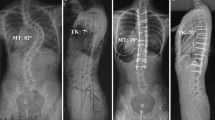Abstract
Purpose
We sought to clarify the effect of applying derotation maneuvers in the correction of adolescent idiopathic scoliosis (AIS) on the sagittal plane.
Methods
We retrospectively queried a large, multicenter, prospectively collected database for patients who underwent surgical correction of AIS. All patients had at least 2 years of follow-up and documentation as to whether or not a derotation maneuver was performed during surgery. All patients underwent posterior spinal fusion with pedicle screw constructs. Patients who underwent concurrent anterior procedures were excluded.
Results
A total of 323 patients were identified, of whom 66 did not have direct vertebral body derotation (DVBD) maneuvers applied during the deformity correction. The remaining 257 had a vertebral body derotation maneuver performed during their surgical correction. Although no significant differences were identified between the two groups when comparing pre-op and post-op thoracic kyphosis using T2–12 and T5–12 endplates, the absolute change in angulation measured from T2–12 was significantly different between the two groups. Postoperatively, the derotation group had a mean decrease in thoracic kyphosis of 5.1 ± 15.3° as compared to 10.8 ± 18.9° in the control group, P = 0.03.
Conclusion
Although patients in both groups had decreased mean thoracic kyphosis postoperatively, application of DVBD in the correction of scoliosis did not additionally worsen the sagittal profile.






Similar content being viewed by others
References
Dickson RA (1992) The etiology and pathogenesis of idiopathic scoliosis. Acta Orthop Belg 52:21–25
Stokes IA, Sangole AP, Aubin CE (2009) Classification of scoliosis deformity three-dimensional spinal shape by cluster analysis. Spine 34:584–590
Glassman SD, Bridwell K, Dimar JR et al (2005) The impact of positive sagittal balance in adult spinal deformity. Spine 30:2024–2029
Betz RR, Harms J, Clements DH et al (1999) Comparison of anterior and posterior instrumentation for correction of adolescent thoracic idiopathic scoliosis. Spine 24:225–239
Suk S, Choon KL, Won-Joong K et al (1995) Segmental pedicle screw fixation in the treatment of thoracic idiopathic scoliosis. Spine 20:1399–1405
Kim YJ, Lenke LG, Cho SK et al (2004) Comparative analysis of pedicle screw versus hook instrumentation in posterior spinal fusion of adolescent idiopathic scoliosis. Spine 29:2040–2048
Lowenstein JE, Matsumoto H, Vitale MG et al (2007) Coronal and sagittal plane correction in adolescent idiopathic scoliosis: a comparison between all pedicle screw versus hybrid thoracic hook lumbar screw constructs. Spine 32:448–452
Rose PS, Lenke LG, Bridwell KH et al (2009) Pedicle screw instrumentation for adult idiopathic scoliosis. Spine 34:852–857
Lee SM, Suk SI, Chung ER (2004) Direct vertebral rotation: a new technique of three-dimensional deformity correction with segmental pedicle screw fixation in adolescent idiopathic scoliosis. Spine 29:343–349
Helgeson MD, Shah SA, Newton PO et al (2010) Evaluation of proximal junctional kyphosis in adolescent idiopathic scoliosis following pedicle screw, hook, or hybrid instrumentation. Spine 35:177–181
Clements DH, Betz RR, Newton PO et al (2009) Correlation of scoliosis curve correction with the number and type of fixation anchors. Spine 34:2147–2150
Bradford DS, Tribus CB (1994) Current concepts and management of patients with fixed decompensated spinal deformity. Clin Orthop Relat Res 306:64–72
Booth KC, Bridwell KH, Lenke LG et al (1999) Complications and predictive factors for the successful treatment of flatback deformity (fixed sagittal imbalance). Spine 24:1712–1790
Weatherley CR, Draycott V, O’Brien JF et al (1987) The rib deformity in adolescent idiopathic scoliosis. J Bone Joint Surg Br 69:179–182
Gupta MC, Wijesekera S, Sossan A et al (2005) Reliability of radiographic parameters in neuromuscular scoliosis. Spine 32:691–695
Goldberg MS, Poitras B, Mayo NE et al (1988) Observer variation in assessing spinal curvature and skeletal development in adolescent idiopathic scoliosis. Spine 13:1371–1377
Morrissy RT, Goldsmith GS, Hall EC et al (1990) Measurement of the Cobb angle on radiographs of patients who have scoliosis. Evaluation of intrinsic error. J Bone Joint Surg Am 72:320–327
Luk KDK, Vidyadhara S, Lu DS, Wong YW, Cheung WY, Cheung MC (2010) Coupling between sagittal and frontal plane deformity correction in idiopathic thoracic scoliosis and its relationship with postoperative sagittal alignment. Spine 35:1158–1164
Roaf R (1966) The basic anatomy of scoliosis. J Bone Joint Surg Br 48:786–792
Somerville EW (1952) Rotational lordosis: the development of single curve. J Bone Joint Surg Br 34:421–427
Porter RW (2001) The pathogenesis of idiopathic scoliosis: uncoupled neuro-osseous growth? Eur Spine J 10:473–481
Kim YJ, Bridwell KH, Lenke LG et al (2005) Proximal junctional kyphosis in adolescent idiopathic scoliosis following segmental posterior spinal instrumentation and fusion: minimum 5-year follow-up. Spine 30:2045–2050
Acknowledgments
This study was supported by a research Grant from DePuy Spine to the Harms Study Group.
Conflict of interest
None.
Author information
Authors and Affiliations
Corresponding author
Rights and permissions
About this article
Cite this article
Hwang, S.W., Samdani, A.F., Gressot, L.V. et al. Effect of direct vertebral body derotation on the sagittal profile in adolescent idiopathic scoliosis. Eur Spine J 21, 31–39 (2012). https://doi.org/10.1007/s00586-011-1991-3
Received:
Revised:
Accepted:
Published:
Issue Date:
DOI: https://doi.org/10.1007/s00586-011-1991-3




